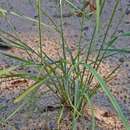Description
provided by Bibliotheca Alexandrina LifeDesk
A loosely tufted, annual, slender plant, usually straggling and ascending from a decumbent base; much-branched and rooting from the lower nodes. Leaf-sheaths are glandular, ligule is membranous, or a ciliolate membrane; leaf blade has an acuminate apex. Inflorescence is linear with short oblong to cuneate, densely crowded, stiff racemes, more or less elliptic-oblong or pyramidal. Spikelets are 1–3 flowered and narrowly cuneate. Fruit is an ellipsoid caryopsis with adherent pericarp.
- author
- BA Cultnat
- provider
- Bibliotheca Alexandrina
Distribution in Egypt
provided by Bibliotheca Alexandrina LifeDesk
Nile region, oases, Mediterranean region, Gebel Elba and Sinai.
- author
- BA Cultnat
- provider
- Bibliotheca Alexandrina
Description
provided by eFloras
Culms usually straggling from a decumbent base, much branched, rooting at lower nodes, infrequently erect, green or purplish green, up to 50 cm or more tall. Leaf sheaths glabrous or with scattered hairs; leaf blades linear, 3–25 × 0.3–0.5 cm, glabrous or thinly pilose, apex acuminate; ligule lacerate. Inflorescence 6–20 cm, narrowly elliptic-oblong to pyramidal, open; racemes 0.5–4 cm, stiff, ascending when young, reflexing and finally deciduous from the axis at maturity; rachis flattened, narrowly winged. Spikelets narrowly cuneate, florets 2–3; glumes narrowly elliptic with caudate diverging tips, 6–8 mm, keel scabrid, minutely glandular; lemmas greenish, narrowly ovate, 2–3 mm, lower part of veins appressed-pilose, acute to emarginate, mucronate; palea appressed-pilose on the flaps. Callus obtuse, glabrous. Anthers purplish red, ca. 0.3 mm. Fl. and fr. Nov–Dec.
- license
- cc-by-nc-sa-3.0
- copyright
- Missouri Botanical Garden, 4344 Shaw Boulevard, St. Louis, MO, 63110 USA
Description
provided by eFloras
Loosely tufted annual; culms up to 112 cm high, slender, usually straggling and ascending from a decumbent base, often rooting at the lower nodes. Leaves glandular especially on the sheaths; leaf-blades 4.5-28 cm long, 4-8 mm wide, finely pointed. Inflorescence 8-34 cm long, linear or elliptic-oblong to pyramidal; spikes 0.6-5(7) cm long, stiff, ascending at first, reflexing and deciduous at maturity. Spikelets 1-3-flowered, narrowly wedge-shaped, 5.7-9 mm long, closely over-lapping on the flattened, narrowly green-winged rhachis; glumes narrowly elliptic with caudate curving tips, 6.1-8.2 mm long, coriaceous, asymmetric, usually over-lapping on the abaxial side and obscuring the florets, glandular along the keel; lemmas narrowly ovate, 2.1-2.9 mm long, appressed pilose along the lateral nerves and on the lower half of the back around the central nerve, acute to emarginate, mucronulate; palea appressed pilose on the flaps alongside the keels.
- license
- cc-by-nc-sa-3.0
- copyright
- Missouri Botanical Garden, 4344 Shaw Boulevard, St. Louis, MO, 63110 USA
Distribution
provided by eFloras
Fujian, Yunnan [native to India, Africa, and Madagascar].
- license
- cc-by-nc-sa-3.0
- copyright
- Missouri Botanical Garden, 4344 Shaw Boulevard, St. Louis, MO, 63110 USA
Synonym
provided by eFloras
Cynosurus retroflexus Vahl, Symb. Bot. 2: 20. 1791; Dine-bra brevifolia Steudel; D. retroflexa var. brevifolia (Steudel) T. Durand & Schinz.
- license
- cc-by-nc-sa-3.0
- copyright
- Missouri Botanical Garden, 4344 Shaw Boulevard, St. Louis, MO, 63110 USA
Physical Description
provided by USDA PLANTS text
Annuals, Terrestrial, not aquatic, Stems nodes swollen or brittle, Stems geniculate, decumbent, or lax, sometimes rooting at nodes, Stems caespitose, tufted, or clustered, Stems terete, round in cross section, or polygonal, Plants viscid, sticky, glandu lar-hairy, Stem internodes hollow, Stems with inflorescence less than 1 m tall, Stems with inflorescence 1-2 m tall, Stems, culms, or scapes exceeding basal leaves, Leaves mostly cauline, Leaves conspicuously 2-ranked, distichous, Leaves sheathing at base, Leaf sheath mostly open, or loose, Leaf sheath smooth, glabrous, Leaf sheath and blade differentiated, Leaf blades linear, Leaf blades 2-10 mm wide, Leaf blades mostly flat, Leaf blades mostly glabrous, Ligule present, Ligule an unfringed eciliate membrane, Inflorescence terminal, Inflorescence solitary, with 1 spike, fascicle, glomerule, head, or cluster per stem or culm, Inflorescence with 2 or more spikes, fascicles, glomerules, heads, or clusters per culm, Inflorescence a panicle with narrowly racemose or spicate branches, Inflorescence branches more than 10 to numerous, Rachis dilated, flat, central axis to which spikelets are attached, Rachis winged, Flowers bisexual, Spikelets sessile or subsessile, Spikelets later ally compressed, Spikelet less than 3 mm wide, Spikelets with 1 fertile floret, Spikelets with 2 florets, Spikelets with 3-7 florets, Spikelets solitary at rachis nodes, Spikelets all alike and fertille, Spikelets bisexual, Spikelets disarticulating below the glumes, Spikelets disarticulating beneath or between the florets, Spikelets falling with parts of disarticulating rachis or pedicel, Inflorescence branches deciduous, falling intact, Rachilla or pedicel glabrous, Glumes present, empty bracts, Glumes 2 clearly present, Glumes equal or subequal, Glumes equal to or longer than adjacent lemma, Glume equal to or longer than spikelet, Glumes keeled or winged, Glumes 1 nerved, Lemmas thin, chartaceous, hyaline, cartilaginous, or membranous, Lemma 1 nerved, Lemma glabrous, Lemma apex dentate, 2-fid, Lemma awnless, Lemma mucronate, very shortly beaked or awned, less than 1-2 mm, Lemma margins thin, lying flat, Lemma straight, Palea present, well developed, Palea membranous, hyal ine, Palea about equal to lemma, Palea 2 nerved or 2 keeled, Palea keels winged, scabrous, or ciliate, Stamens 3, Styles 2-fid, deeply 2-branched, Stigmas 2, Fruit - caryopsis, Caryopsis ellipsoid, longitudinally grooved, hilum long-linear.

